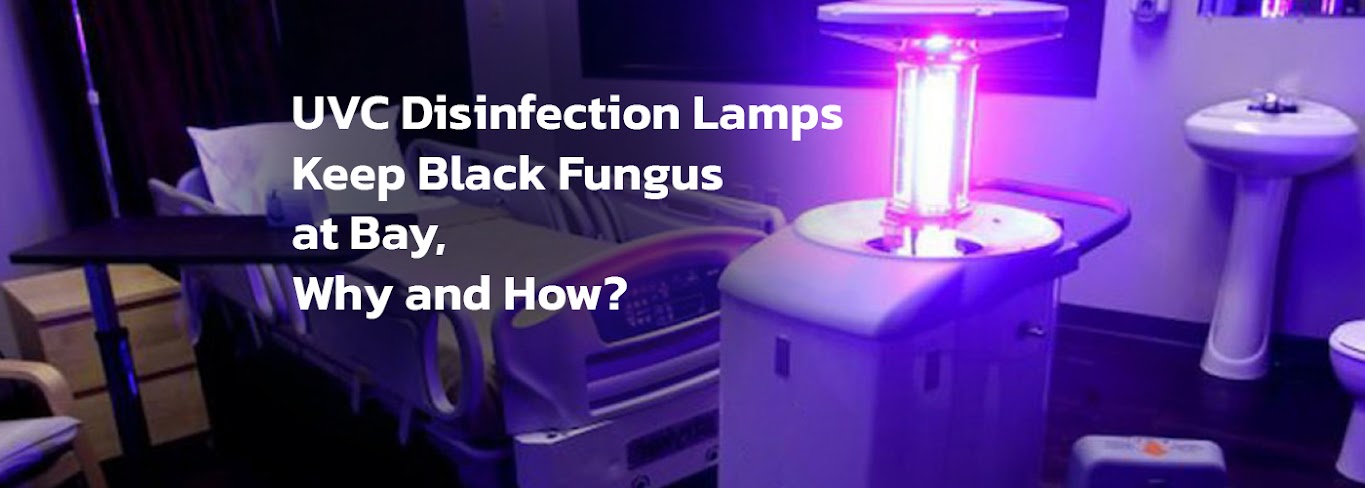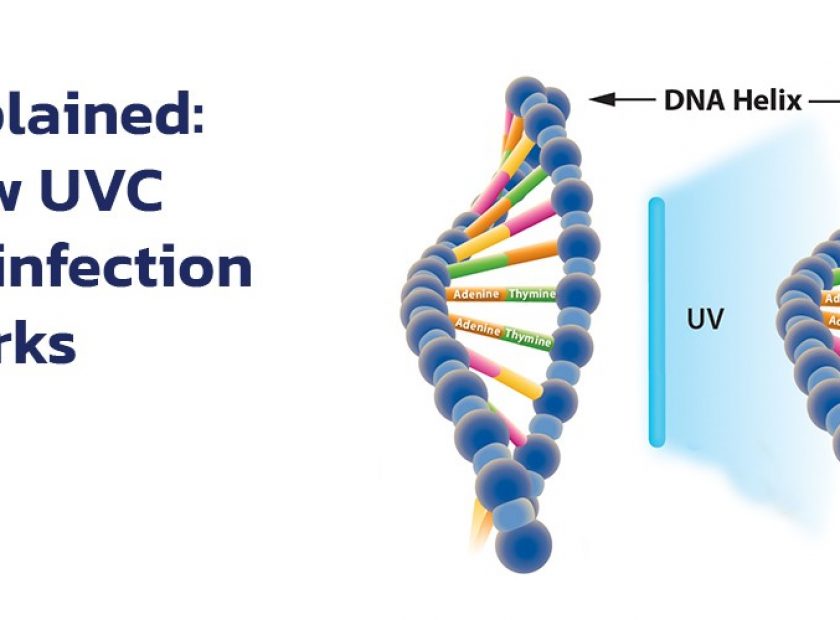UVC Disinfection Lamps Keep Black Fungus at Bay, Why and How?

UVC Disinfection Lamps
Ultraviolet light is a form of electromagnetic radiation emitted by a variety of sources, the most prominent of which is the sun. This form of light is all around you, but it is invisible to the naked eye. Vitamin D is produced by the human body using ultraviolet light, which is why it is recommended that people go outside on a regular basis to improve their vitamin D absorption.
While too much UV light can be detrimental, it can also be helpful in a variety of ways.
If you work in a facility that requires sanitation, for example, ultraviolet light can be used in a variety of situations where sanitation is needed.
Since this light can destroy bacteria and viruses without the use of toxic chemicals, it is often used to sterilize biological research and medical facilities. UV light, when used correctly, can also destroy Virus causing diseases like COVID and Black Fungus.
How Does the Virus Affect Us?
The mold is otherwise known as a virus. The virus is a fungus made up of microscopic organisms that can be found almost anywhere. Viruses will appear in a variety of colors, including orange, white, black, green, and purple. The virus is dangerous when it enters a home or factory, but it is beneficial in nature because it aids in the decomposition of dead trees, leaves, and plants.
The Black Fungus Virus is known to grow in large numbers in places where there is a lot of moisture. Although small amounts of viruses are virtually harmless, when virus spores come into contact with wet surfaces and spread, they can become dangerous in a home or company. After that, spores can be spread in the air, where they can be inhaled by someone nearby. The virus can cause a variety of health issues if you are exposed to it too often.
Although hazardous, viruses can still be handled in a number of ways. If the virus has grown on surfaces, you will most likely need to discard some of the virus-affected products if the concentrations are excessive. The surface virus can, however, be scrubbed away with bleach and water cleaning solution.
UV light, on the other hand, has been shown to be very effective at destroying virus spores without the use of chemicals. The spores can dissipate when this light comes into contact with the virus.
How is UV effective?
UV light is a form of light that the human eye cannot see. This electromagnetic radiation is primarily emitted by the sun, but it may also come from a variety of other sources. UV-C, which has a very short wavelength, is the kind of ultraviolet light that is capable of effectively neutralizing the virus. UV light is widely used for disinfection purposes, which may involve treating ballast water with UV disinfection, due to how useful UV light can be in the right quantities.
Since UV light has so many uses, it’s crucial to understand what it is. UV light can be used to detect biological materials, clean water, and eliminate viruses. Ultraviolet light has a higher frequency than normal light, which allows it to penetrate the skin and be effective in a variety of applications.
Uses of UVC Light
UV light has a wide range of uses, including:
- Bacterial and viral disinfection
- Coatings and inks, for example, are dried and cured.
- Controlling the hygiene of tanning
- Inspection with a fluorescent light
- Purification of water
- Getting rid of the virus
Since ultraviolet light is usually contained in a UV lamp, it can be used for a variety of purposes. These lamps provide a targeted dose of ultraviolet light when used correctly, which is why they can destroy viruses without the use of any additional chemicals.
How does UVC actually Kill Bacteria and Viruses?
Bacteria, viruses, and a variety of other pathogens, including the Black Fungus, are all killed by UV light when used correctly. UV light is widely used to destroy viruses inside air conditioning systems, but it can be used anywhere in your home or facility. Though UV light is used to destroy viruses in many industries, its primary application is microbial decontamination for air purification, water treatment, and other applications.
UV light is germicidal when used at short wavelength frequencies, which means it can kill and remove germs. Viruses can also be damaged by UV light because of their short wavelengths. UV light has proved to be highly efficient at destroying viruses because the light blankets the whole room where the lamp is used, allowing the whole area to be disinfected. Although manual cleaning methods can remove these pathogens, they are typically time-consuming and ineffective.
An ultraviolet lamp installed in an HVAC system can help keep the whole system virus-free. Keep in mind that the overall efficacy of UV lights for killing viruses is determined by the length of time the virus is exposed to the light as well as the intensity of the light. UV lights with a higher intensity are normally more effective at killing viruses than UV lights with a lower intensity.
UV light can efficiently destroy viruses because the electromagnetic radiation it emits acts as a disinfectant and can pass through living organisms. As this light is inserted in a lamp and sent out in short wavelengths, it kills the majority of virus cells while also preventing the remaining cells from reproducing before they die out. Because of how easily the virus can spread, using ultraviolet light to prevent it from spreading while also destroying it can be very successful.
Manually removing the virus is ineffective because even a single missed spot of the virus will replicate and spread at the same rate as before the area was cleaned. When using ultraviolet light, the entire region over which the light is spread should be virus-free in a short time. As ultraviolet rays strike virus cells, they destroy the nucleic acids that make up the cells’ DNA.
How to Tackle Black Fungus with UVC?
If you’re aware of how the black fungus problem is beginning to expand, and given it’s ensued from COVID, the first thing you’d want to do is to get a UV-C lamp, which comes in a variety of styles and sizes to fit a variety of needs. After you’ve purchased a UV-C lamp, the next step is to determine which surfaces are actually infested with viruses. Any surfaces you overlook may cause viruses to thrive and spread throughout your home or business.
Next, maintain a distance of two inches between the UV-C lamp and the virus-infected regions. In order for the UVC Disinfection lamp light to kill all of the virus, any other light source in the room must be switched off. This includes any doors or windows that might allow a small amount of light to pass through. Leave the room for 1-2 hours, after which the virus could have vanished. Repeat for any other surfaces where viruses are present.
When the light is switched on, make sure you don’t stare at it directly. Although there are special UV glasses that will shield your eyes, if you wear regular eyeglasses, your vision can be harmed. It’s important to wear gloves if you handle a UV bulb to prevent the bulb from harming your skin.
What’s the UVC lamp’s efficacy?
The virus is easily killed by ultraviolet radiation. The virus cells gradually die off after an hour or two because the light directly penetrates the virus cells and destroys the nucleic acids. Manual removal of viruses and the use of a fogging machine are two other popular methods for destroying viruses.
If you want to manually remove viruses from your house, you’ll need to mix water with a chemical, the most common of which is bleach. Every spot of the virus must be attended to while using this method, which can be a time-consuming and exhausting operation. When manually killing the virus, it’s also easy to miss a spot.
Cold thermal foggers are the most popular fogging machines used to destroy viruses. When used in conjunction with an air conditioner, they spray a disinfectant throughout the device to destroy and damage viruses. The main advantage of this approach is that it allows the spray to penetrate all parts of the device rather than just one. It’s also likely that the spray could disrupt the HVAC unit’s circuit board.
The following are the key benefits of using UV light to destroy viruses:
- The virus can be killed faster than with other methods.
- Is usually more successful than other options.
- It enables you to minimize the use of chemicals.
- Virus cells can be eliminated in 99.9% of cases.
The Conclusion
The upshot is that using UV lights to destroy viruses can remove all viruses in your home or company without requiring the use of toxic chemicals or the installation of expensive foggers. Since the light penetrates the virus, it is extremely successful at removing the virus from the lamp’s target area. UV-C lamps may be used for a variety of purposes, including air purification, food sanitation, furniture disinfection, and drying and curing.
If you want to start using UV light to destroy viruses, all you have to do is buy a UV lamp, which comes in a variety of different forms. The price of these lamps may also vary greatly. You should be able to get rid of the virus in a couple of hours by keeping the light directly on the virus.
Read also: Things that are Important for Offices Opening Post-Pandemic



